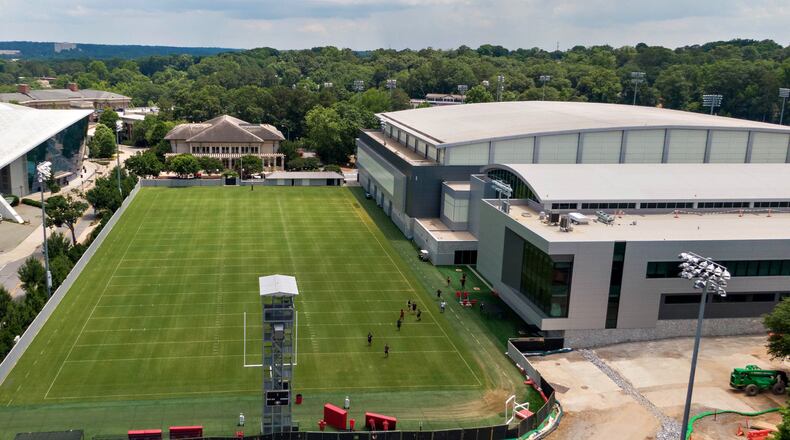ATHENS — Money has been pouring into Georgia Athletic Association coffers for a while now. And it’s pouring out as well.
The association’s board of directors, at its winter meeting Wednesday afternoon at the Georgia Center for Continuing Education, received a facilities and development report that could make a billionaire blush. Already in the midst of nearly $200 million worth of ongoing construction projects, the Bulldogs are about to add to it.
Construction on a new outdoor track-and-field facility is set to start this summer at a location off South Milledge Avenue. Fundraising is well underway, according to Athletic Director Josh Brooks, but he would not reveal how much has been raised or what the total cost of the project will be. However, it’s not expected to be cheap, as tons of groundwork will have to be done to level out the area on university land where the track will be built.
“This is a project I’m very passionate about,” said Brooks, who was the track-and-field sport administrator before he became athletic director. “This isn’t going to be the Oregon track, although I’d love to build the Oregon track, but this is going to be an extremely functional track facility that can support SEC and regional track meets as well as day-to-day practice needs.”
Eventually, a funding request will need to be submitted to the athletic board, presumably before the end-of-year meeting in late May at the Ritz-Carlton Lodge on Lake Oconee.
The outdoor track will be Phase I of what is hoped to be two-phase project that also will introduce an adjacent indoor track-and-field facility. Land to the north already has been acquired for that purpose. The hope is that the Bulldogs will be able to host regional and national track competitions, something their current facilities cannot accommodate. Those facilities were promised to men’s and women’s track coach Caryl Smith Gilbert when she came to Georgia from Southern Cal in the summer of 2021.
A new track means that Spec Towns Track, which has been at its current location parallel to Lumpkin Street since 1964, will be demolished. In its place, Georgia football coach Kirby Smart is expected to get the two additional practice fields he so covets.
The Bulldogs have been limited to basically two outdoor fields – one is only 80 yards long – since the new football facility was completed in 2021. The Bulldogs have a 100-yard, artificial turf field inside the Payne Indoor Facility.
Georgia athletics currently has at least $178.7 million worth of construction projects actively underway on campus. The Bulldogs are well into Phase 2 of the $68.5 million Sanford Stadium improvement project. After expanding the south-side concourses and adding a plaza and hundreds of restroom facilities, Georgia is converting the Dan Magill Press Box into a premium-seating space for donors and adding a tower in the southwest corner that will accommodate media and add limited auxiliary seating areas.
Georgia’s baseball stadium is wrapping up Phase I of a two-phase, $45 million project it is calling the Foley Field Enabling Project. Also, the Jack Turner softball complex is in the midst of getting a $38.5 addition, and the Dan Magill Tennis Complex is nearing the end of $26.7 million project to add a new six-court, indoor tennis facility.
In addition, UGA is renovating the interior of the Heritage Hall area of the Butts-Mehre building and converting it into what will be known as the Circle of Champions rotunda. That construction budget was set at $2 million.
“President Morehead and I wanted to do something to honor coach (Vince) Dooley,” Brooks said.
Georgia also has spent at least $4 million on its recent refurbishment of Stegeman Coliseum. That, however, was just “phase 1-A” of a “Stegeman Coliseum Master Plan and renovation.” Office spaces therein are being renovated for the first time since 2007. In addition to repairing the ceiling and painting the entire interior black, a new weight room and training room has been built and eventually a giant scoreboard will be added. Since the building is owned by the university and shared with athletics, some of the costs are being shared.
“We want to put emphasis on improving things that directly impact our student-athletes’ lives,” Brook said.
About the Author
Keep Reading
The Latest
Featured


